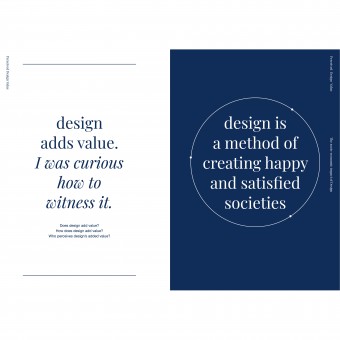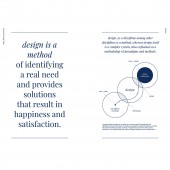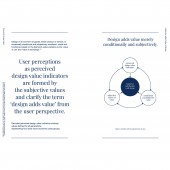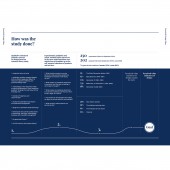Perceived Design Value Research by Aija Freimane |
Home > Winners > #116447 |
 |
|
||||
| DESIGN DETAILS | |||||
| DESIGN NAME: Perceived Design Value PRIMARY FUNCTION: Research INSPIRATION: The objective of this research was to decode design added value by identifying aspects that may help businesses, governments, and society apply design more consciously and mindfully to determine the value proposition as a customer-perceived value and total customer benefit. UNIQUE PROPERTIES / PROJECT DESCRIPTION: The postdoctoral research in design clarifies the added value of design from the perspectives of users spanning five generations and four socioeconomic class groups by recommending perceived value indicators of design that measure satisfaction, happiness, and well-being as end results of product and service usage. OPERATION / FLOW / INTERACTION: The defined perceived value indicators of design succeeded in reflecting conditional subjective values and contributed to developing user-centered design-driven businesses by understanding meanings that people feel, sense, and receive when using products and services. PROJECT DURATION AND LOCATION: The project started in October 2017 in Latvia and finished in September 2020 and was financed by the European Regional Development Fund and the Republic of Latvia. |
PRODUCTION / REALIZATION TECHNOLOGY: The postdoctoral study in Design - new knowledge and theory of design's added value: defined design definition and design among other disciplines, described triple design process, decoded perceived value indicators of design, developed self-assessment design's maturity matrix. SPECIFICATIONS / TECHNICAL PROPERTIES: Research for Design, The book of the main research results A5, 89 pp. Innovative approach on design's added value from the user perspective by analyzing design's socioeconomic impact from five generations and four socioeconomic class groups. TAGS: Design added value, Design's socieoconomic impact, Design indicators, conditionally subjective value, generations, socioeconomic class groups RESEARCH ABSTRACT: The postdoctoral research as the local–global case study clarifies the added value of design from the perspectives of users spanning five generations and four socioeconomic class groups by recommending perceived value indicators of design that measure cultural and personal satisfaction, happiness, and well-being as end results of product and service usage. CHALLENGE: The challenge was to address the need to measure the socioeconomic impact of design and the role of design alongside other intangible assets in value creation identified by the European Commission. Ideas such as “good design always creates good value” and “design adds value” support the proposition that design impacts society and contributes to the economy but do not provide reliable and evidence-based tools to demonstrate that fact. ADDED DATE: 2021-01-23 10:51:24 TEAM MEMBERS (1) : Solo research. IMAGE CREDITS: Full postdoctoral research "Identification system of Design's socioeconomic impact": https://01a185bd-defe-4101-9c4c-67cf29c9e773.files usr.com/ugd/ed7c53_09da1ba5702449b2adc3fabfe02a3e2 1.pdf |
||||
| Visit the following page to learn more: https://www.aijafreimane.com/ | |||||
| AWARD DETAILS | |
 |
Perceived Design Value Research by Aija Freimane is Winner in Meta, Strategic and Service Design Category, 2020 - 2021.· Read the interview with designer Aija Freimane for design Perceived Design Value here.· Press Members: Login or Register to request an exclusive interview with Aija Freimane. · Click here to register inorder to view the profile and other works by Aija Freimane. |
| SOCIAL |
| + Add to Likes / Favorites | Send to My Email | Comment | Testimonials | View Press-Release | Press Kit |
Did you like Aija Freimane's Service Design?
You will most likely enjoy other award winning service design as well.
Click here to view more Award Winning Service Design.








